Listen to This Article:
Have you ever wondered why restaurant dishes recreated at home often don’t have the same taste and appeal even when following a same recipe? The answer may simply be that professional chefs know the right knife cutting techniques to use with each ingredient. Using the right cutting technique can help improve efficiency and consistency while elevating the taste and presentation of a dish.
So, whether you’re a home cook looking to improve your skills or a professional chef looking to set yourself apart in the competitive culinary industry, learning how to improve your knife techniques can make the difference.
This guide can help you improve your essential knife skills and take your culinary creations to the next level.
A Quick Introduction to Knives
Before diving into the techniques, it’s important to understand the different types of knives and their uses. Here are a few of the most common:
- Chef’s Knife: Versatile and used for a wide range of tasks, from chopping vegetables to slicing meat
- Paring Knife: Ideal for peeling and intricate work, such as deveining shrimp or cutting small garnishes
- Boning Knife: Designed for removing bones from meat, poultry, and fish, with a flexible and narrow blade
- Serrated Knife: Perfect for slicing bread, tomatoes, and other foods with tough exteriors and soft interiors
- Utility Knife: Smaller than a chef’s knife but larger than a paring knife, used for miscellaneous cutting tasks
Tips for Choosing and Maintaining Knives
- Invest in high-quality knives to ensure longevity and precision.
- Keep your knives sharp using honing steel or a sharpening stone.
- Clean and dry your knives immediately after use to prevent rust and maintain hygiene.
5 Essential Knife Techniques for Every Chef
Knife techniques are one of the foundations of culinary expertise. Whether you’re crafting a simple salad or a complex gourmet meal, refining these skills can help elevate your cooking by boosting the visual appeal, texture, and flavor of the dish.
Let’s explore five of the crucial knife cutting techniques that every chef should know.
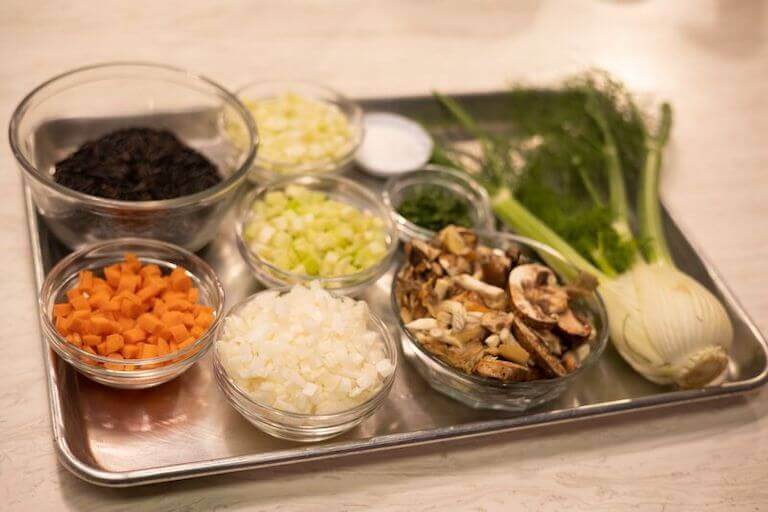
Using the right techniques for the right dish will help ensure consistent results.
1. The Rock Chop
Just like it sounds, the rock chop involves a rocking motion of the knife. This technique is ideal for chopping herbs, garlic, and other small items. It allows for quick and efficient chopping with minimal strain.
Grip the knife handle with one hand, keeping the tip of the blade on the cutting board, and “rock” the end of the knife to cut the ingredients. The tip of the knife will slide on the cutting board but will not lift off of it. Your other hand will move the ingredients toward the blade to continue making cuts.
Practical Application: The rock chop is perfect for making a mirepoix, the classic French flavor base of diced onions, celery, and carrots used in soups, stews, and sauces. It’s also a cut that may be used by prep cooks as they prepare ingredients.
2. The Cross Chop
The cross chop is used to quickly cut ingredients when you’re not worried about their final appearance. For example, cutting small vegetables or herbs.
This cut is very similar to the rock chop, except you use your free hand to secure the tip of the blade in one place, and your cutting hand rocks the remainder of the knife blade back and forth over the ingredients.
Practical Application: A saucier may use the cross chop for preparing fresh pesto, where finely chopped basil, garlic, and pine nuts are blended with olive oil and cheese to create a vibrant sauce.
3. Trimming
Trimming is about removing excess fat, sinew, or unwanted parts from ingredients, essential for preparing meats and certain vegetables. This can help improve the cooking quality and presentation of a dish.
It can be helpful to use a flexible boning knife when trimming. Hold the knife at a slight angle and gently slice away unwanted parts, being careful not to remove too much of the edible portion.
Practical Application: Trimming the fat cap and cleaning the bones to create a French-style rack of lamb. In a professional kitchen, the Boucher (Butcher) typically trims the meat.

Properly trimmed meat can be an important step in setting your recipe up for success.
4. Peeling
Peeling involves removing the outer skin or peel from fruits and vegetables. It’s commonly used with carrots, potatoes, and apples.
To peel, you would use a paring knife or peeler, hold the ingredient firmly, and gently peel away the skin. Keep the blade sharp to avoid tearing the flesh, and practice with different types of peelers to find the most comfortable one.
Practical Application: Peeling helps create smooth mashed potatoes or apple pie filling, where peeled fruits and vegetables ensure the desired texture. In commercial kitchens, this is a task that Commis Chefs or line cooks may be responsible for.
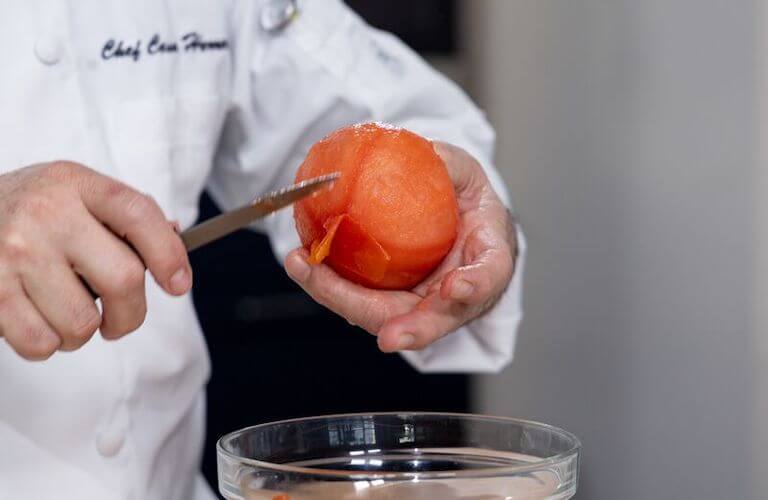
Peeling the skin from fruits and vegetables can help you achieve your desired texture in a dish.
5. The Chop
The chop involves a straightforward up-and-down cutting motion, perfect for larger, more uniform pieces of vegetables, fruits, and other ingredients. This technique is great for achieving consistent results quickly.
Hold the knife with a firm grasp and chop it up and down, making sure to keep your fingers tucked under using the claw grip. Maintain an even pressure and control the height and speed of the chops.
Practical Application: The chop can be used for preparing a chopped salad, where diced lettuce, tomatoes, cucumbers, and bell peppers create a fresh and colorful dish. This is a technique that may be used by Garde-Mangers or Commis Chefs.
Advanced Knife Techniques for the Skilled Chef
The knife cutting techniques above are commonly used in professional kitchens and even home kitchens. Once you’re comfortable with these types of techniques, you may want to try your hand at some more advanced techniques, such as the following:
- Katsuramuki: This Japanese technique is used to turn cucumber or daikon radish into a long, thin sheet. It involves a high level of knife precision and control. The technique is commonly used for dishes like maki rolls.
- Oblique Cut (Roll Cut): This cut is used to help ingredients absorb more flavor or achieve better caramelization by creating a larger surface area. You cut at an angle while rolling the ingredient. It’s often used in restaurants for stir-fries and braised dishes.
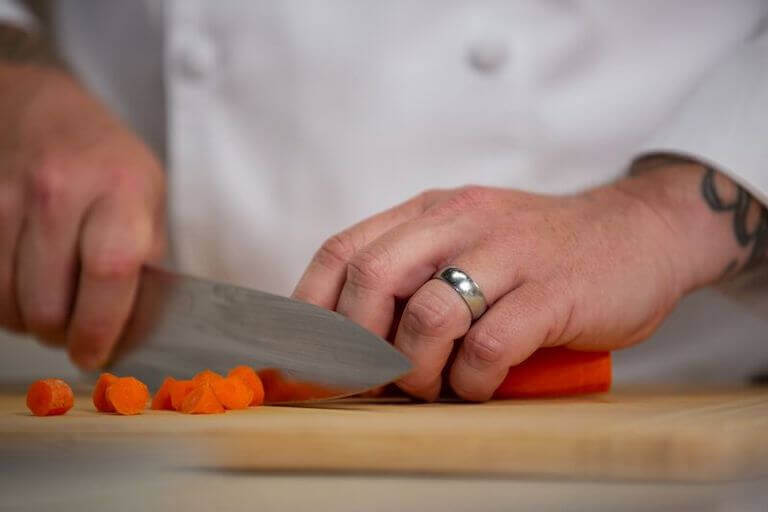
The oblique cut is an advanced technique used in commercial kitchens.
- Sogigiri (Slicing Cut): This technique also involves thinly slicing fish or meat at an angle to increase surface area. It’s a crucial technique used for sushi.
- Canele: This is a decorative cut that uses a peeler or special knife to create a fluted pattern. It’s used for high-end food presentation and for garnishes.
- Fluting: This cut is used on mushrooms and other vegetables to enhance the visual appeal with a decorative cut. It’s often used for fine dining presentation and requires artistic skill and precision.
These advanced techniques can be used to create more sophisticated culinary creations while enhancing the flavor and texture of dishes.
How Knife Skills Improve Your Cooking
Knife skills aren’t simply about cutting ingredients. They can help you reduce prep time, minimize food waste, and lower your risk of accidents in the kitchen. In addition, different cutting techniques can help transform the cooking process.
Using the right cutting technique can elevate the quality of your dishes by enhancing flavors and visual appeal. You can reduce the chance of overcooking or undercooking ingredients by making uniform cuts, leading to consistency in the texture of your dish. In addition, the right knife cut can release more of the ingredients’ natural flavors.
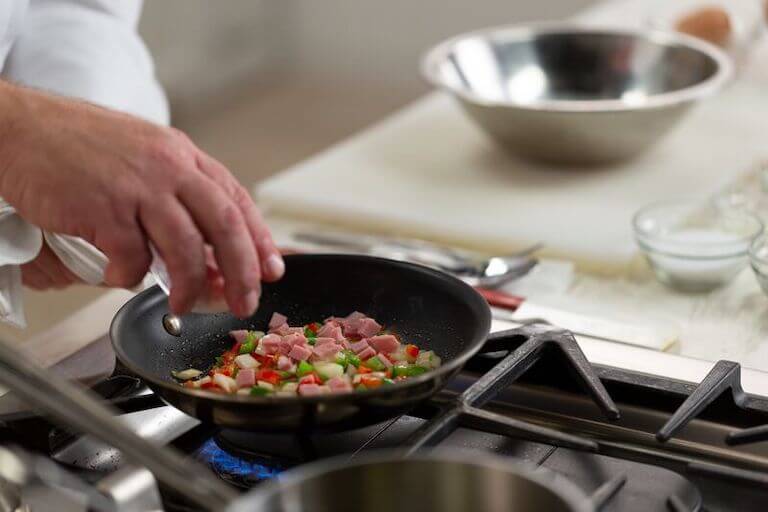
Cutting ingredients uniformly can help them cook evenly, improving the texture of a dish.
For example, finely chopped herbs can distribute their flavors thoroughly throughout a dish, enchanting the taste. Properly slicing vegetables can help maintain their vibrant color and structural integrity during cooking, which can help improve the appeal and nutritional quality of the dish.
Safety Tips to Keep in Mind
With the right knife selected, it’s crucial to use proper knife safety techniques, whether you’re in a professional restaurant or cooking at home.
Begin by ensuring you’re working with a sharp knife. They are less likely to slip and require less force when cutting than a dull knife. You also want to ensure you’re cutting on a stable surface. You can create a non-slip base by placing a moist dish towel beneath your cutting board.
Always pay full attention when using knives and avoid distractions. Make sure that you’re cutting away from your body when possible to avoid cutting yourself. In addition, use the proper grip to help protect your fingers as you cut.
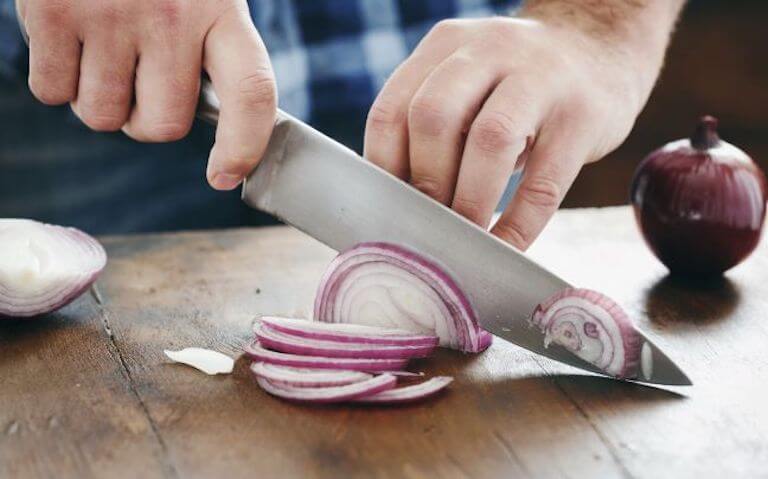
Knife safety is crucial to reduce accidents in the kitchen.
Proper Grip Techniques to Use When Cutting
Using the proper grip starts with how you hold your knife. Escoffier Chef Instructor Anthony Frazier shares that “Your knife should feel like an extension of your arm, from your elbow through the tip of the knife should be one unit.”
*Information may not reflect every student’s experience. Results and outcomes may be based on several factors, such as geographical region or previous experience.
For cuts such as the rock chop and slice, you want to use the “claw grip” to hold ingredients while you’re cutting. This grip can help with control and precision while protecting your fingers.
Step-by-Step Guide for the Claw Grip
- On the hand you’ll use to hold the ingredients, curve your fingers inward, forming a claw shape.
- Ensure your fingertips are tucked under and your knuckles are slightly protruding. This protects your fingers from the knife blade.
- Use your knuckles to guide the knife. Rest the side of the knife blade against your knuckles to keep it steady and controlled.
- Use the claw grip to securely hold the food, moving your hand back as you cut to maintain a consistent grip.
- Ensure your thumb is tucked behind your fingers and out of the knife’s path.
- Start slowly, focusing on maintaining the grip and moving the knife smoothly. With practice, this grip can become second nature.
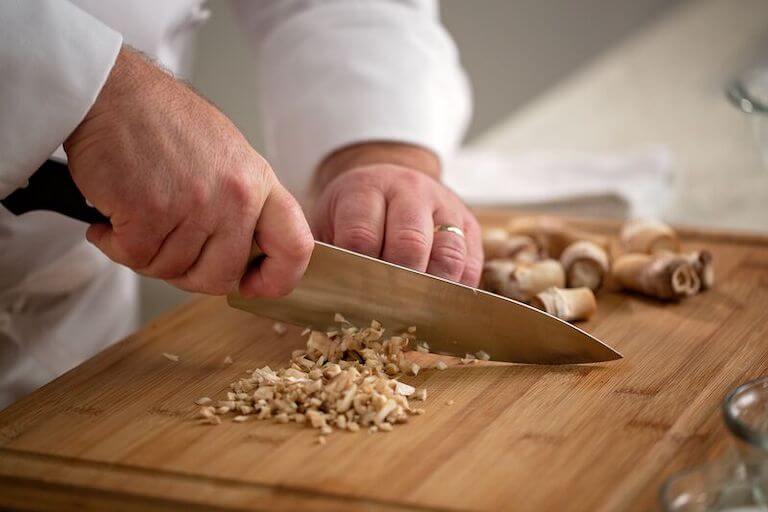
The claw grip helps protect your fingers and thumb while cutting.
Improve Your Knife Skills and Set Yourself Apart in the Culinary Industry
Developing these skills can help you achieve the desired results of the dishes you make, leading to consistent and delicious results. Regular practice can enhance your efficiency, precision, and safety in the kitchen.
Knife cutting techniques are some of the essential skills that help build a strong foundation that students are taught in Escoffier’s Culinary Arts Program. With these skills in your culinary repertoire, you can potentially set yourself apart from others in the competitive culinary world.
If you’re interested in further developing your cooking skills and exploring careers in the industry, contact us today to learn more about obtaining a culinary education.


